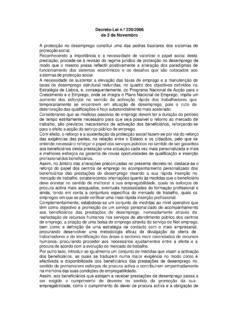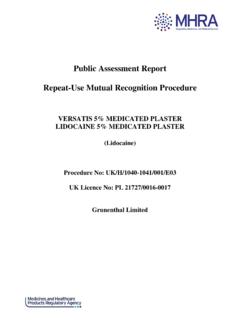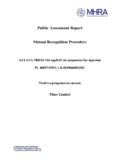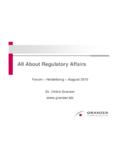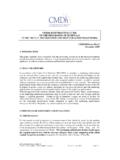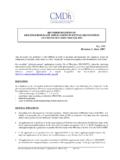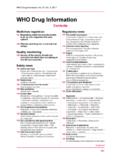Transcription of Performance Assessment in the Public Services of the EU ...
1 Performance Assessment in the Public Services of the EU Member States Procedure for Performance appraisal, for employee interviews and target agreements Performance Assessment in the Public Services of the EU Member States Procedure for Performance appraisal, for employee interviews and target agreements Study for the 48th meeting of the Directors-General of the Public Service of the Member States of the European Union Dr. Christoph Demmke, Professor of Comparative Administration Sciences European Institute of Public Administration Maastricht (NL) Maastricht, June 2007 3 I. TASK AND OBJECTIVE OF THE STUDY .. 5 1. 5 2. Methodology and research status .. 6 II. THEORETIC PART: Performance APPRAISAL AND Performance MEASUREMENT .. 10 1. Basics: Definition of Performance measurement and Performance motivation .. 10 What influences Performance ? .. 10 Measuring complex performances in Public service.
2 11 An excursion into psychology: what factors influence the Performance motivation?.. 14 2. Linking Performance appraisal to Performance -related 16 III. PRACTICAL PART: Performance APPRAISAL SYSTEMS BETWEEN TRADITION AND REFORM .. 23 1. Traditional Performance appraisal systems .. 23 2. Reforms: Staff interviews, target agreements and Performance -based contracts .. 28 Positive aspects .. 31 Problematic aspects .. 35 IV. SHARED CHALLENGES IN Performance APPRAISAL .. 41 1. 41 2. Findings on the effectiveness and acceptance of the systems .. 43 3. Between simplification and increased 47 4. Management under changed conditions a delicate topic .. 53 5. The employee/superior relationship and the reality of cooperative management styles .. 58 6. Inadequate poor performers policy .. 64 7. A never-ending issue: Ratings .. 65 8. Discrimination of employees .. 68 V. EXAMPLES OF GOOD PRACTICES FOR Performance MANAGEMENT SYSTEMS ..69 1.
3 The structure of allowance and Performance appraisal systems in 69 Target agreements and Performance agreements .. 72 Status of 74 An unbureaucratic example the "Danish Commerce and Companies Agency" .. 75 Evaluation of the Performance appraisal 2. Finland Central Administration and Ministry of Finance .. 79 General .. 79 Structure of the Performance appraisal system ..80 Performance appraisal procedure .. 81 Performance appraisal in Ministries of Finance (with Statistics Finland and Road Administration as case studies) .. 83 Evaluation of the Performance appraisal 3. Great 85 Introduction .. 85 The Performance appraisal system in the Cabinet 88 Evaluation of the Performance appraisal VI. COMPARATIVE SURVEYS WHAT CAN WE LEARN FROM OTHERS? 91 1. Best practices?.. 92 2. General success factors .. 94 3. Selected 96 V. BIBLIOGRAPHY .. 100 VII. APPENDIXES .. 100 4 AUTHOR'S PREFACE This study has "grown" over a period of 18 months.
4 After intensive literature research, a preliminary study for the Federal Ministry of the Interior started in the winter of 2005/2006. Within the scope of this work, case studies were done in individual authorities in Denmark, Finland and Great Britain. Finally the main Europe-wide comparative study started in the winter of 2006/2007. For this purpose, the EUPAN Human Resource Working Group was presented with a questionnaire, which has been answered by 24 member states, as well as Norway and the European Commission. Subsequently workshops were organised and the results of the study discussed with human resource experts. The document in front of you is the result of this work. All member states, Norway and the European Commission have thus contributed to and accompanied the inception of this study. Many member states supplied additional interesting comments, reference material and documents.
5 I hope that this study will contribute to a productive debate among the directors-general of the Public service of the EU member states, as well as Norway and the European Commission. I would like to thank everybody who contributed to this study; especially my colleagues in the EUPAN Human Resources Working Group (HRWG), as well as the German EU presidency who commissioned this study. In the Federal Ministry of the Interior, Dr. Manfred Sp th in particular supported me in writing this study. I hope this study offers numerous interesting facts and that it will be of great interest to all EU member states, thus contributing to our target of information exchange and mutual learning. This study was written in German. I would like to thank the translators for rendering this paper into English and French (which certainly is not an easy thing to do). Because of the need for translation, many quotations and the footnotes were left in the original wherever possible (English, mostly).
6 This study is intended as aid for all those who have the difficult task of introducing a new Performance appraisal system and who are interested in learning about the experiences other countries made in the field of Performance appraisal. Due to the practical target of this study, theoretical aspects are (only) included if they promote better understanding of this study and the statements it contains. At the EIPA, Willem Huwae, Thomas Hen kl, Denise Grew and Chris Alard in particular assisted me in developing and conducting this study. For this assistance I would also like to express my heartfelt thanks. Christoph Demmke 5I. TASK AND OBJECTIVE OF THE STUDY 1. Task In the course of the reforms in the European Public Services , many administrations have in the past few years introduced new instruments for measuring the Performance of their staff. Portugal, Spain, Poland, Hungary and Germany are currently in the process of introducing a new appraisal system.
7 In Portugal, the revision of the Performance appraisal system is particularly necessary, since the new reform framework of attachments/links, careers and remunerations shall come into force at the beginning of 2008 . In France, a report of the committee "sur le co t et le rendement des Services publics" (2006) recommended continuing with the reform of the appraisal system and in particular to further developed the instrument of target agreements. In the European Commission, the current system is also being revised towards a system based on those factors that were identified as positive ( self- Assessment , objective-based appraisal, annual dialogue, recognition of personal development ). Other member states implement systems that have been introduced recently, and/or are planning to introduce new systems. Furthermore approximately half of the EU member states have taken measures to establish a closer tie between Performance and remuneration.
8 All Public service reform concepts in the EU member states have in common that individual Performance should in future be better promoted and rewarded, but also evaluated and sanctioned. With increasing frequency, new Performance appraisal systems are introduced, for example appraisals that are to be conducted based on target agreements. To this purpose, Europe-wide procedures and guidelines are being developed, to enable a comparative Performance Assessment with as little bureaucratic effort as possible. This study investigates if and how these targets are achieved. Classic Performance appraisals have in the past few years been viewed very critically across Europe. Frequently Performance appraisals are (if conducted at all) perceived as necessary chores in the everyday administrative life. Neither the superiors nor the employees were interested in the appraisals.
9 However, this lack of interest derived from different reasons. Whereas the one group did not wish to conduct evaluations, the other group did not wish to be evaluated. Frequently Performance appraisals had no consequences: In many cases, the appraisals had no significant effects on the work conditions of the personnel. The principle of life-long employment contracts, the seniority principle and more or less automatic promotions put the use of Performance appraisals to question. The appraisal system itself represented another weakness: Bureaucratic requirements and a multitude of criteria to be evaluated led to subjective results. This subjectivity has been frequently and rightly criticised. Another point that yielded much criticism is the tendency to assign ratings that are too high, in order to prevent internal personnel management conflicts. In the meantime, the traditional legitimation problems involved with the instrument of Performance appraisal have changed fundamentally.
10 Additionally the instrument itself has significantly gained importance. In many member states, the Performance appraisal is increasingly and more consistently linked to consequences for the personnel. These consequences affect Performance agreements, Performance -related pay, career development, promotions, and increasingly also job security. With these changes, the instrument of Performance appraisal has gained a position at the core of human resource management. Yet the changes are not limited to the increased importance of this instrument. In fact, the increased significance also demands improved application and professionalisation of the entire management process. This study investigates and analyses this reform process. 6 Other developments are not so obvious, but that does not mean that they are less important: Previous Performance Assessment systems did not make the individual Performance Assessment the focus behind the criteria.

